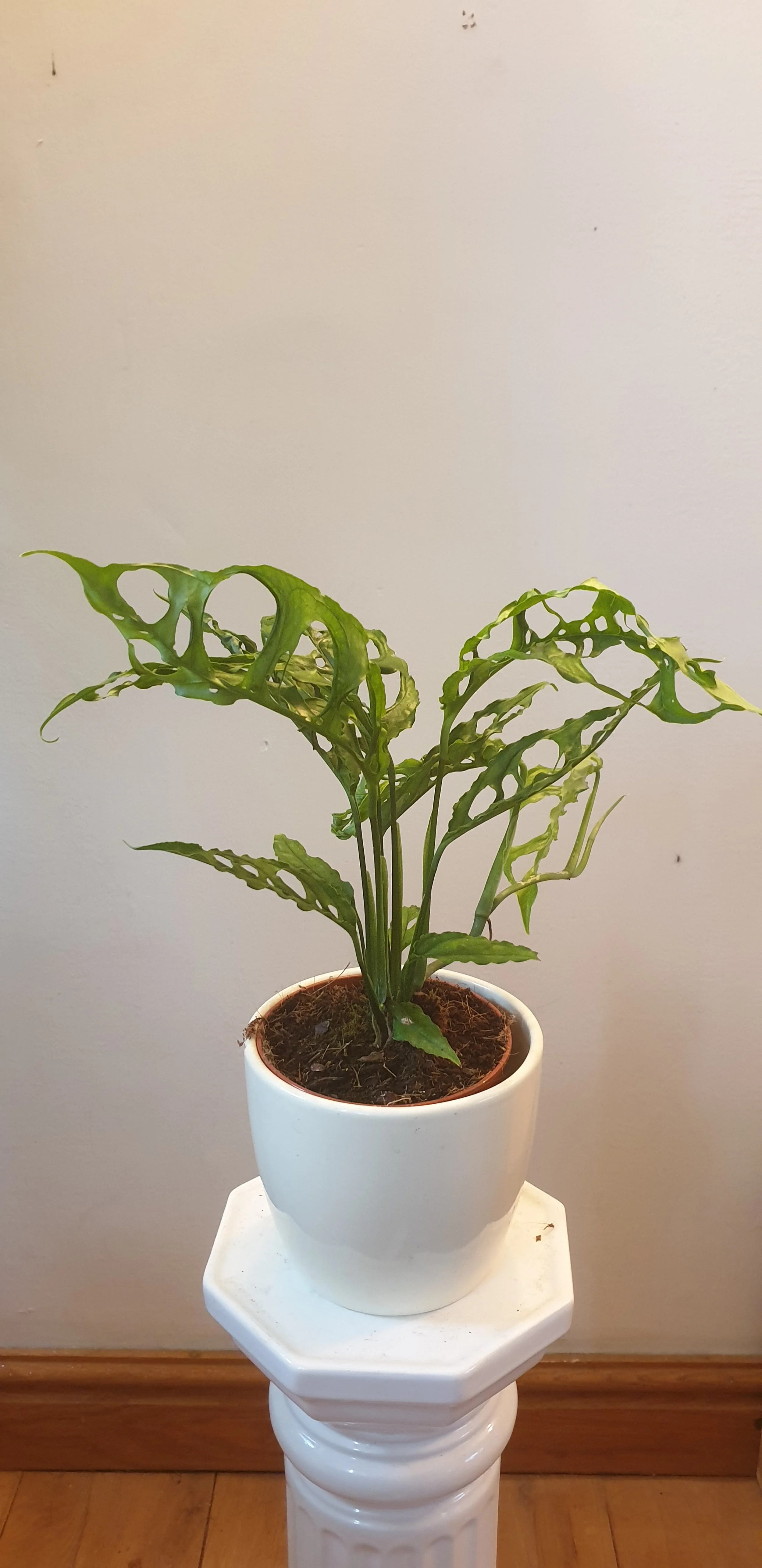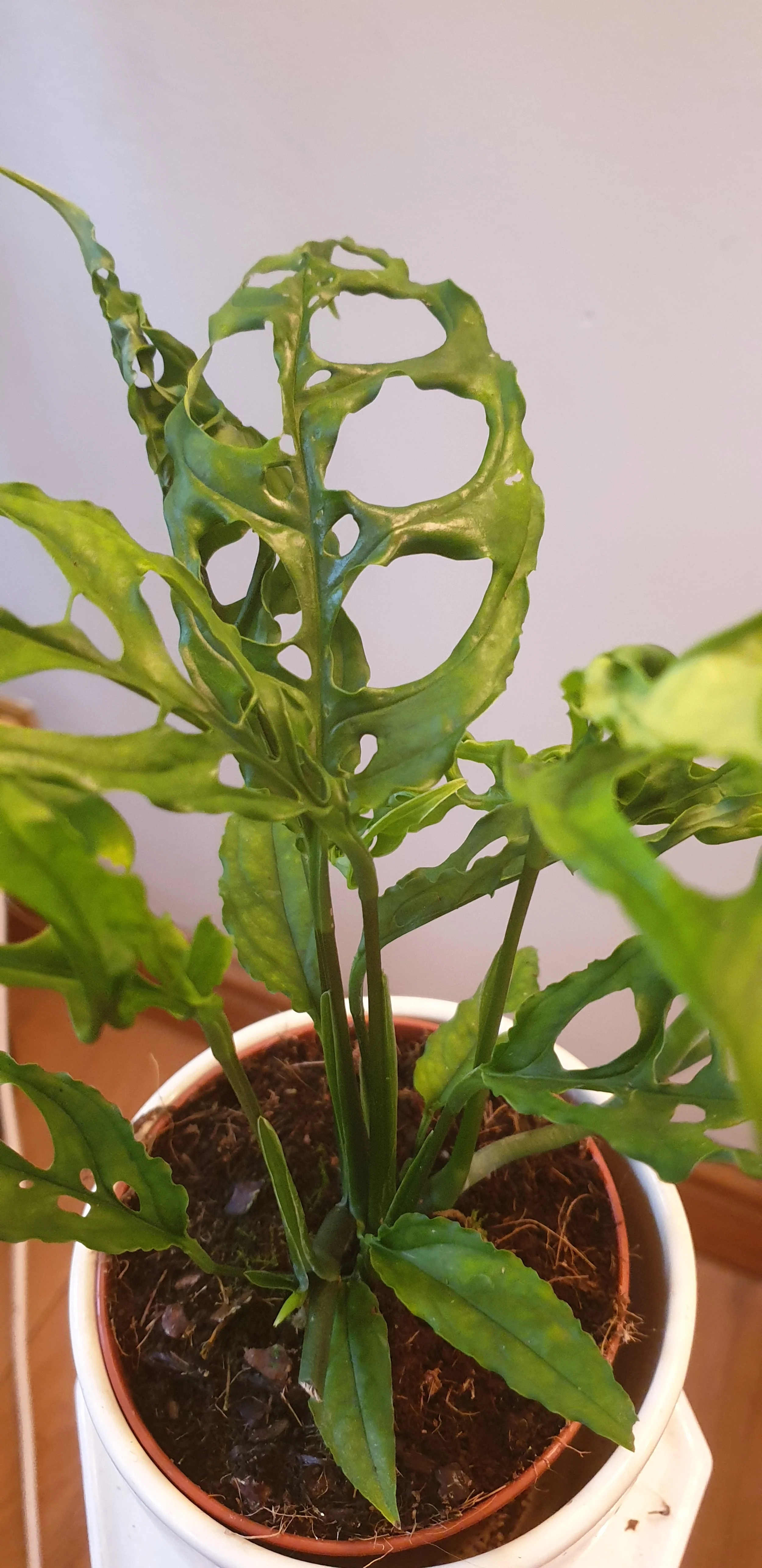 Image 1 of 2
Image 1 of 2

 Image 2 of 2
Image 2 of 2



Monstera ' Peru' in 12cm pot.
🌿 Monstera Peru – Description
Botanical Name: Monstera karstenianum (commonly sold as Monstera peru)
Common Names: Monstera Peru, Karstenianum, Shingle Plant (occasionally confused with Rhaphidophora cryptantha)
Family: Araceae
Native Region: South America (Peru, Ecuador, Venezuela)
✅ Key Features:
Leaves: Thick, glossy, dark green, with deeply textured, puckered (quilted) surfaces.
Unlike most Monstera species, Monstera peru does not naturally develop fenestrations (holes or splits).
Growth Habit: A vining epiphyte that climbs using aerial roots. Grows well with a support like a moss pole.
Size: Indoors, it can grow 3–6 ft (1–2 m) or more with proper support.
---
🪴 Monstera Peru – Care Guide
Though rare, Monstera peru is relatively low-maintenance and grows fast with the right care.
---
☀️ Light
Prefers bright, indirect light.
Tolerates medium light, but growth slows and color may dull.
Avoid direct sun, especially afternoon rays—it can scorch the thick leaves.
---
💧 Watering
Water when the top 1–2 inches (2–5 cm) of soil feel dry.
Avoid overwatering — Monstera peru is prone to root rot in soggy soil.
Use room-temperature filtered or rainwater if possible.
---
🌱 Soil
Likes a chunky, well-draining aroid mix.
Ideal: potting soil + orchid bark + perlite + coco coir or peat.
Good aeration is important due to the thick root system.
---
🌡️ Temperature & Humidity
Temperature: 65–85°F (18–29°C). Avoid drops below 60°F (15°C).
Humidity: Prefers high humidity (60–80%), but can adapt to average household levels.
Browning edges may occur in very dry air.
---
🌸 Fertilizer
Feed every 4–6 weeks during spring and summer using a balanced liquid fertilizer diluted to half strength.
Pause feeding in winter or dormant periods.
---
🪴 Support & Growth
As a natural climber, Monstera peru benefits from a moss pole, trellis, or totem.
Climbing leads to stronger growth and larger leaves.
It can also trail from a hanging basket or shelf.
---
✂️ Pruning & Propagation
Prune to manage size or encourage bushier growth.
Easy to propagate via stem cuttings:
Cut below a node with at least one leaf.
Root in water, sphagnum moss, or moist soil.
Transplant once roots are well developed (2–3 inches).
---
🐛 Pests & Problems
Problem Cause Fix
Yellow leaves Overwatering, poor drainage Let soil dry more, check for root rot
Brown leaf edges Low humidity or underwatering Increase humidity, water consistently
Slow or leggy growth Not enough light or no support Move to brighter light, give it a pole
Pests Spider mites, mealybugs, thrips Wipe leaves; treat with neem oil or insecticidal soap
---
🐾 Pet Safe?
❌ No. Like all Monsteras, Monstera peru is toxic to pets and humans if ingested (contains calcium oxalates).
---
✅ Summary – Quick Care Recap
Feature Ideal Condition
Light Bright, indirect light
Watering Let topsoil dry out slightly
Humidity 60%+ preferred
Soil Chunky, well-draining aroid mix
Growth Style Vining – climbs or trails
Toxicity Toxic to pets & people
🌿 Monstera Peru – Description
Botanical Name: Monstera karstenianum (commonly sold as Monstera peru)
Common Names: Monstera Peru, Karstenianum, Shingle Plant (occasionally confused with Rhaphidophora cryptantha)
Family: Araceae
Native Region: South America (Peru, Ecuador, Venezuela)
✅ Key Features:
Leaves: Thick, glossy, dark green, with deeply textured, puckered (quilted) surfaces.
Unlike most Monstera species, Monstera peru does not naturally develop fenestrations (holes or splits).
Growth Habit: A vining epiphyte that climbs using aerial roots. Grows well with a support like a moss pole.
Size: Indoors, it can grow 3–6 ft (1–2 m) or more with proper support.
---
🪴 Monstera Peru – Care Guide
Though rare, Monstera peru is relatively low-maintenance and grows fast with the right care.
---
☀️ Light
Prefers bright, indirect light.
Tolerates medium light, but growth slows and color may dull.
Avoid direct sun, especially afternoon rays—it can scorch the thick leaves.
---
💧 Watering
Water when the top 1–2 inches (2–5 cm) of soil feel dry.
Avoid overwatering — Monstera peru is prone to root rot in soggy soil.
Use room-temperature filtered or rainwater if possible.
---
🌱 Soil
Likes a chunky, well-draining aroid mix.
Ideal: potting soil + orchid bark + perlite + coco coir or peat.
Good aeration is important due to the thick root system.
---
🌡️ Temperature & Humidity
Temperature: 65–85°F (18–29°C). Avoid drops below 60°F (15°C).
Humidity: Prefers high humidity (60–80%), but can adapt to average household levels.
Browning edges may occur in very dry air.
---
🌸 Fertilizer
Feed every 4–6 weeks during spring and summer using a balanced liquid fertilizer diluted to half strength.
Pause feeding in winter or dormant periods.
---
🪴 Support & Growth
As a natural climber, Monstera peru benefits from a moss pole, trellis, or totem.
Climbing leads to stronger growth and larger leaves.
It can also trail from a hanging basket or shelf.
---
✂️ Pruning & Propagation
Prune to manage size or encourage bushier growth.
Easy to propagate via stem cuttings:
Cut below a node with at least one leaf.
Root in water, sphagnum moss, or moist soil.
Transplant once roots are well developed (2–3 inches).
---
🐛 Pests & Problems
Problem Cause Fix
Yellow leaves Overwatering, poor drainage Let soil dry more, check for root rot
Brown leaf edges Low humidity or underwatering Increase humidity, water consistently
Slow or leggy growth Not enough light or no support Move to brighter light, give it a pole
Pests Spider mites, mealybugs, thrips Wipe leaves; treat with neem oil or insecticidal soap
---
🐾 Pet Safe?
❌ No. Like all Monsteras, Monstera peru is toxic to pets and humans if ingested (contains calcium oxalates).
---
✅ Summary – Quick Care Recap
Feature Ideal Condition
Light Bright, indirect light
Watering Let topsoil dry out slightly
Humidity 60%+ preferred
Soil Chunky, well-draining aroid mix
Growth Style Vining – climbs or trails
Toxicity Toxic to pets & people